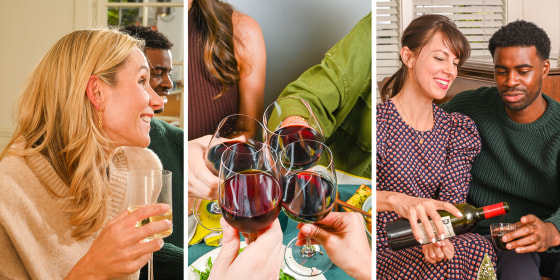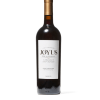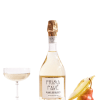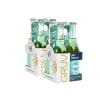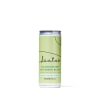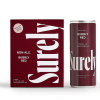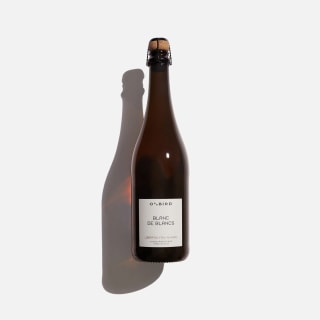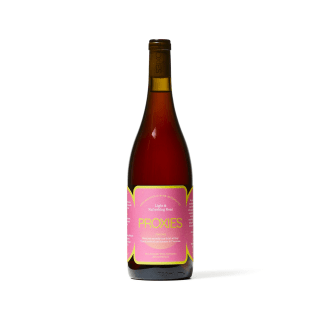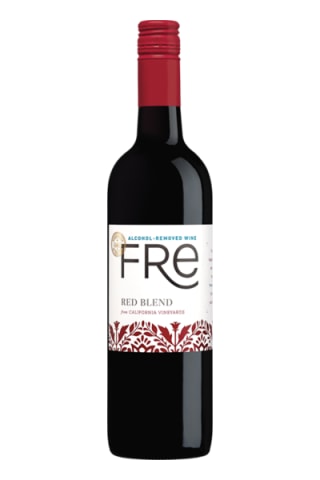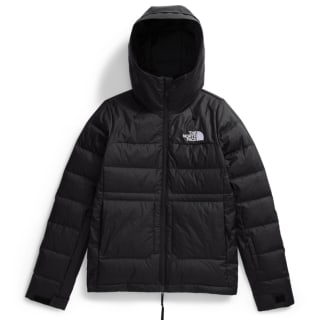In the past few years, nonalcoholic wine has become an important part of many people’s New Year’s resolutions. In fact, around 39% of consumers say they’re open to trying a sober-curious lifestyle, according to surveys from Mintel, a market research firm. This means many people are examining their relationship with alcohol and experimenting with drinking less than they usually do. And while interest in nonalcoholic wine tends to peak around Dry January and Sober October — months during which some people take extended breaks from alcohol — many are incorporating these beverages into their lifestyles year round.
The first thing to know about nonalcoholic wines is that they don’t taste exactly like their alcoholic counterparts. But many varieties come pretty close, offering a substitute for people who choose not to drink, yet don’t want to give up the ritual of having a glass of wine at dinner or a party. To help you find the best nonalcoholic wines for your flavor preferences, I spoke to experts about how to shop for reds, whites and rosés.
SKIP AHEAD What is non-alcoholic wine? | How I picked the best nonalcoholic wine | Best nonalcoholic wine to shop | Why trust NBC Select?
What is nonalcoholic wine?
Before you start shopping, it’s important to understand what it is. There are two types of nonalcoholic wine, and how each is made impacts its flavor profile. One type is not better than the other, says Anne Guarino, the category merchant analyst for wine at Whole Foods Market. What you like is a matter of personal preference.
Alcohol-removed wine
Alcohol-removed wine is exactly what it sounds like — wine that alcohol is removed from. Manufacturers first follow the traditional wine-making fermentation process, which converts sugar to alcohol, to create alcoholic wine in reds, whites and rosés. It then undergoes a de-alcoholization process, leaving behind a beverage with a similar aroma, flavor and finish to full-strength wine, says Guarino. Wine that has 0.5% or less alcohol by volume (ABV) is considered “nonalcoholic,” according to the U.S. Food and Drug Administration.
Proxy wine
Proxy wine is made with juice, sometimes from wine grapes, but it never undergoes the fermentation process, so sugar is never converted to alcohol. This means proxy wine has 0% ABV and can’t unlock the distinct flavor of wine that fermentation is responsible for, says Nick Bodkins, CEO and co-founder of Boisson, a nonalcoholic drink retailer with locations in New York and California. Thus, manufacturers incorporate ingredients like fruit extracts, spices and teas to proxy wine, adding to its complexity, says Guarino. These additional ingredients help it emulate some of the notes and fragrances of full-strength wine without undergoing any steps of the wine-making process, says Bodkins. Unlike alcohol-removed wines, proxy wines are not generally classified in the classic red, white and rosé categories, and instead are defined by the flavors, like hibiscus and white tea or thyme and citrus, derived from the ingredients they’re made with.
Want more from NBC Select? Sign up for our newsletter, The Selection, and shop smarter.
How I picked the best nonalcoholic wines
Because everyone’s taste palette is different, shopping for nonalcoholic wine is a bit of a guessing game, experts told me. The only way to thoroughly understand where your preferences lie is to try different brands and varieties. Because of that, there’s really no wrong way to shop and no bad options. Adding a bottle to your shopping cart without putting much thought into it is a totally legitimate entry point to the world of nonalcoholic wine.
That said, experts recommend thinking about the following factors to guide your shopping.
- Type of nonalcoholic wine: If you’re looking for a direct replacement for a certain type of wine, look for the alcohol-removed version. But if you’re in the discovery phase, experts recommend trying a few alcohol-removed and proxy wines to taste the difference and start learning about what you like.
- Flavor profile: Think about what types of full-strength wines you typically enjoy and what regions they’re from. Then, purchase alcohol-removed equivalents. For proxy wine, read about the flavor notes and ingredients listed on the beverage’s label, and consider whether they generally align with your taste preferences. Going to your local wine shop and talking to a salesperson can also be very helpful when figuring out what flavors you gravitate toward, says Guarino.
- Carbonation: You can buy still and sparkling nonalcoholic wines. Bodkins recommends starting with sparkling if you’re specifically interested in trying alcohol-removed wines. They’re usually the closest in taste to their alcoholic counterparts because of carbon dioxide, which creates bubbles and helps carry the scents, flavors and aromas to your nose and tongue, he says.
- Packaging: Nonalcoholic wines are available in bottles and cans. The packaging doesn’t affect the beverages’ flavor, but it does impact their use case, says Guarino. Bottled wine is great for serving a crowd and gifting, while canned wine usually has individual servings and is more portable, so you can bring it to barbecues and picnics, for example.
The best nonalcoholic wine
I rounded up our expert’s favorite options along with nonalcoholic wines NBC Select staff enjoy. I included alcohol-removed and proxy wines, plus those available in bottles and cans.
Joyus Non-Alcoholic Cabernet Sauvignon
- Pairs well with cheese
- Low in calories
- Vanilla undertones
Alcohol in red wine effectively carries the beverage’s aromas and tasting notes, so the flavor of its nonalcoholic counterpart doesn’t stack up quite as well as whites and rosés, says Bodkins. That said, there are still great options on the market, like this cabernet sauvignon from Joyus, which comes recommended by Chris Marshall, founder and owner of Sans Bar, a nonalcoholic bar in Austin, Texas. The red wine is aged on American oak and has notes of berries and vanilla, according to the brand. Bodkins suggests drinking nonalcoholic red wine a bit colder than you would drink alcoholic red wine to better bring out the flavor.
Type: alcohol-removed | Carbonated: no | Packaging: bottle
OddBird Blanc de Blancs Chardonnay
- Sparkling
- Apple flavored
- Made in France
- Sweet taste
Produced in southern France, the Blanc de Blanc sparkling chardonnay from OddBird combines the tastes of Grannysmith apples, honey and lime. It’s aged for one year before having the alcohol removed, leaving behind a fresh and complex fruit flavor. NBC Select associate reporter Bianca Alvarez is a fan and says it’s a great option when you aren’t in the mood for standard wine. “They have different wines but Blanc de Blancs is by far my favorite,” she says. “It’s very fruity and light and I love that because it’s sparkling, it enhances that light and airy feeling you get when drinking it.”
Type: alcohol-removed | Carbonated: yes | Packaging: bottle
Leitz Eins Zwei Zero Chardonnay
- Made in Germany
- Has a subtle lemon flavor
- Pairs well with rich foods
- Has a dry finish
This chardonnay was one of the first alcohol-removed wines I tried and it even got the seal of approval from many of my friends who were weary about nonalcoholic vino. It’s light and crisp, and has a relatively long aftertaste, making it nice to sip slowly. The chardonnay offers fruity and citrus notes, plus a dry finish, according to the brand. To best bring out its flavor, Bodkins recommends drinking flat nonalcoholic white wine warmer than you would normally drink full-strength white wine.
Type: alcohol-removed | Carbonated: no | Packaging: bottle
Prima Pavé Blanc De Blancs
- Made in Italy
- Made from a white wine blend
- Pairs well with seafood
- Sweet taste
Prima Pave’s Blanc De Blancs is one of Marshall’s favorite nonalcoholic wines. It’s a sparkling blend of three white grape varieties: pinot grigio, sauvignon blanc and gewürztraminer. Together, these grapes create notes of white peach, green apple, honeydew, kiwi and elderflower, according to the brand. The wine has a dry finish.
Type: alcohol-removed | Carbonated: no | Packaging: bottle
Lautus De-Alcoholised Wine Sauvignon Blanc
- Made in South Africa
- Has tropical fruit flavors
- Good as an aperitif
- Best for fans of white wine
I always keep a bottle of this white nonalcoholic wine in my refrigerator because it’s light and pairs well with fish, which I often make for dinner. It has a fruity citrus flavor and I chill it prior to serving, which I find makes it even more refreshing to sip. I love that the bottle comes with a screw-off cap, so I can pour myself a glass or two and easily save the rest for the next day.
Type: alcohol-removed | Carbonated: no | Packaging: bottle
Gruvi Dry Secco
- Has a floral flavor
- Sparkling
- Comes in small bottles
- Semi-dry taste
“I actually had to check the label of the Gruvi’s Dry Secco three times when I first had it because it tasted so much like the real thing,” says Casey McGuire Davidson, a sobriety coach who offers courses through her platform Hello Someday Coaching. She recommends serving it at celebrations like New Year’s Eve, or making zero-proof mimosas with it. The beverage comes in single-serve bottles and has a delicate, floral, semi-dry taste, according to the brand. Davidson also likes Gruvi’s Bubbly Rose, and says her clients rave about the brand’s sangaria.
Type: proxy | Carbonated: yes | Packaging: single-serve bottles
Proxies Pink Sea Salt
- Pairs well with seafood
- Citrus flavor
- Best for summer
When I sip Proxies Pink Sea Salt, I get a dry, smooth feel that reminds me of light, full-strength whites and rosés. It is made with ingredients like pinot blanc grapes, peach concentrate, lemon juice and blended tea, which gives it a fruity flavor, but it’s not sweet or juicy, in my experience. I find Proxies refreshing on a warm spring or summer night, and its orange pink color looks beautiful served in clear glasses.
Type: proxy | Carbonated: no | Packaging: bottle
Surely Non-Alcoholic Bubbly Red Can
- Sparkling
- Fruit-forward flavor
- Dry finish
- Cherry taste
Davidson served Surely’s crisp nonalcoholic Brut — a dry Champagne — at her last holiday party and says it was a bit hit among her guests. Many of them normally drink but wanted a nonalcoholic option since they were driving home, and they enjoyed sipping on this bubbly. It has a fuller body and well-balanced flavors, including tasting notes of lemon, peach and passionfruit, according to the brand.
Type: alcohol-removed | Carbonated: yes | Packaging: bottle and cans
Fre Premium Red Blend
- Pairs well with pasta
- Has a cherry aroma
- Made in California
- Subtle smokey flavor
Fre’s Premium Red Blend is my go-to for drinking with tomato-based dishes like pasta with marinara sauce, a hearty soup and pizza. It has a long aftertaste and a rich, smooth, smokey flavor. It has notes of fruity cherry and grapes, according to the brand.
Type: Alcohol-removed | Carbonated: No | Packaging: Bottle
Meet our experts
At NBC Select, we work with experts who have specialized knowledge and authority based on relevant training and/or experience. We also take steps to ensure that all expert advice and recommendations are made independently and with no undisclosed financial conflicts of interest.
- Nick Bodkins is the CEO and co-founder of Boisson, a nonalcoholic drinks retailer with locations in New York and California.
- Chris Marshall is the owner and founder of Sans Bar, an alcohol-free bar in Austin, Texas.
- Anne Guarino is the category merchant analyst for wine at Whole Foods Market. She earned a Wine & Spirit Education Trust Level 2 award and supports Whole Foods’ wine team by managing data, reports and fostering supplier communications.
- Casey McGuire Davidson is a life and sobriety coach and the host of the The Hello Someday Podcast for Sober Curious Women.
Why trust NBC Select?
I’m a reporter at NBC Select who writes about food and beverages, including recent stories on olive oil, honey, coffee subscriptions and nonalcoholic spirits. For this article, I interviewed four experts about how to shop for nonalcoholic wine and rounded up expert picks and NBC Select staff recommendations.
Catch up on NBC Select’s in-depth coverage of personal finance, tech and tools, wellness and more, and follow us on Facebook, Instagram, Twitter and TikTok to stay up to date.

